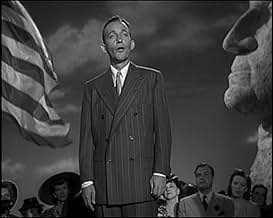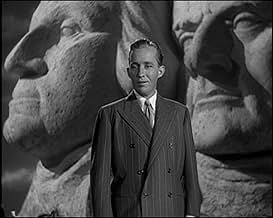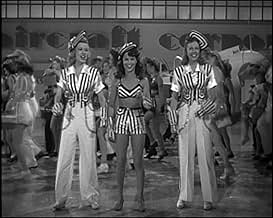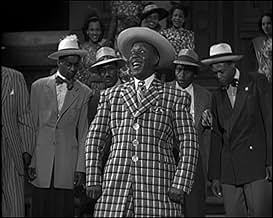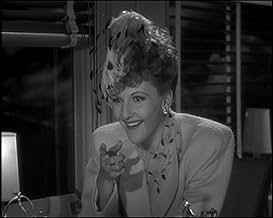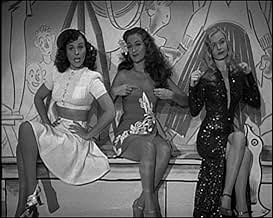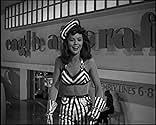AVALIAÇÃO DA IMDb
6,5/10
706
SUA AVALIAÇÃO
Adicionar um enredo no seu idiomaA Paramount Studios security guard who was a major actor during the silent film era must carry out the illusion that he is still a big deal when his sailor son comes to visit.A Paramount Studios security guard who was a major actor during the silent film era must carry out the illusion that he is still a big deal when his sailor son comes to visit.A Paramount Studios security guard who was a major actor during the silent film era must carry out the illusion that he is still a big deal when his sailor son comes to visit.
- Direção
- Roteiristas
- Artistas
- Indicado a 2 Oscars
- 1 vitória e 2 indicações no total
Avaliações em destaque
Pretty much this is Paramount's contribution to the war effort in 1942. Plot basically sees Victor Moore as Pop, who by way of some deceit has to keep up the pretence to his sailor son Johnny Webster (Eddie Bracken) that he is head of the studio, when in fact he is just a gatekeeper there. As Johnny and his sailor pals make their way to the studio, Pop, aided by switchboard operator Polly Judson (Betty Hutton), sets about putting on a all star show for the boys. Cue sketches and variety turns by a ream of Paramount performers. Some of the situ comedy works, such as Bob Hope in the shower with William Bendix and Hutton trying to scale a wall aided by two bendy blokes, other moments, however, fall a little flat. But when the froth is war-oriented or the stars are poking fun at themselves, it scores well and the musical numbers are never less than pleasant.
Good old time cinema while it's also fun to play spot the star. 7/10
Good old time cinema while it's also fun to play spot the star. 7/10
Betty Hutton, one of the nominal stars of Star Spangled Rhythm, was not just doing it for defense as in her number, but the whole studio was doing this All Star flag waver for the defense of the morale of the USA.
I can never resist one of these all star spectaculars and there's only one I would ever have given a bad review to, and this isn't the one. Everybody working on the Paramount lot got to do his bit for defense in this film, some bits being longer than others.
The nominal plot of this film has Betty Hutton as a switchboard girl at Paramount studios and Victor Moore, a former silent western star, now working as a security guard at the studio trying to convince Eddie Bracken and a bunch of his sailor buddies that Moore is really the head of the studio. For that they have to con and bamboozle Walter Abel who is a real studio executive out of his office and off the lot so they can do their masquerade uninterrupted.
Of course Bracken asks the inevitable, pop can you get all these stars down for a big Navy show, and the con has to continue. But all of this nonsense is just an excuse for some musical and comedy numbers by the Paramount players.
Harold Arlen and Johnny Mercer wrote the score and out of it came two really big standards, That Old Black Magic which was nominated for Best Song that year, but lost to another Paramount film song, White Christmas and Hit the Road to Dreamland.
The latter was done as director Preston Sturges was playing himself and screening a musical number from his latest film. As the projector rolls on screen it's Dick Powell and Mary Martin on a Pullman car singing about finally hitting the hay after some romance. The scene is so well done I wish it was included as an integral part of a real film.
That Old Black Magic is sung by Johnny Johnson and danced by ballet star Vera Zorina. It was enormous hit that year, recorded by a flock of singers. Oddly enough not by Bing Crosby though he got to sing it in another film, Here Come the Waves.
Of course the finale is a wartime flag waving number with Bing Crosby singing Old Glory about the flag and the wonders of the country behind it. The number about the flag probably wouldn't fly today still and that's a pity.
It's even more of a pity that these musical extravaganzas are a thing of the past with the decline of the Hollywood studio system. Star Spangled Rhythm is one of the best of its kind.
I can never resist one of these all star spectaculars and there's only one I would ever have given a bad review to, and this isn't the one. Everybody working on the Paramount lot got to do his bit for defense in this film, some bits being longer than others.
The nominal plot of this film has Betty Hutton as a switchboard girl at Paramount studios and Victor Moore, a former silent western star, now working as a security guard at the studio trying to convince Eddie Bracken and a bunch of his sailor buddies that Moore is really the head of the studio. For that they have to con and bamboozle Walter Abel who is a real studio executive out of his office and off the lot so they can do their masquerade uninterrupted.
Of course Bracken asks the inevitable, pop can you get all these stars down for a big Navy show, and the con has to continue. But all of this nonsense is just an excuse for some musical and comedy numbers by the Paramount players.
Harold Arlen and Johnny Mercer wrote the score and out of it came two really big standards, That Old Black Magic which was nominated for Best Song that year, but lost to another Paramount film song, White Christmas and Hit the Road to Dreamland.
The latter was done as director Preston Sturges was playing himself and screening a musical number from his latest film. As the projector rolls on screen it's Dick Powell and Mary Martin on a Pullman car singing about finally hitting the hay after some romance. The scene is so well done I wish it was included as an integral part of a real film.
That Old Black Magic is sung by Johnny Johnson and danced by ballet star Vera Zorina. It was enormous hit that year, recorded by a flock of singers. Oddly enough not by Bing Crosby though he got to sing it in another film, Here Come the Waves.
Of course the finale is a wartime flag waving number with Bing Crosby singing Old Glory about the flag and the wonders of the country behind it. The number about the flag probably wouldn't fly today still and that's a pity.
It's even more of a pity that these musical extravaganzas are a thing of the past with the decline of the Hollywood studio system. Star Spangled Rhythm is one of the best of its kind.
Shortly after the attack on Pearl Harbor, the US mobilized unlike any society before or since.
A large part of that was because of a very cooperative media, especially the new medium of movies. The White House asked them to rush some feel-good films into production and this was paramount's first response. It is a collection of skits wrapped in a thin story. Most of the skit material is in the form of a "show" for sailors, but many of them inexplicably use cinematic conventions that couldn't be staged.
Because this was stitched together so quickly, it is of widely varying tone and quality. I suppose the parts you like will depend on who you are.
There's a pretty big, lush production number (ostensibly a movie being shot that some sailors visit) that has atypically svelte and acrobatic girls. Later, there's a number where black straight man Rochester dances pretty well.
So far as comedy, there are two classic scenes here that made this enjoyable for me: This was Betty Hutton's first big role and she does Lucy better than Lucy I think. One scene is a hilarious attempt to climb over a wall with the aid of two men. It's amazingly physical, worthy of Keaton. Check her out in "Perils of Pauline," also directed by Marshall, who seems to have understood her.
The other comic bit worth seeing is Bob Hope trapped in a shower with William Bendix, and avoiding being discovered. Hope's not a great comic, in fact he falls flat elsewhere in this project. But this one skit is perfect for him.
Preston Sturges is one of the main figures in folded films (films about film), and he plays himself here, screening a film.
Ted's Evaluation -- 2 of 3: Has some interesting elements.
A large part of that was because of a very cooperative media, especially the new medium of movies. The White House asked them to rush some feel-good films into production and this was paramount's first response. It is a collection of skits wrapped in a thin story. Most of the skit material is in the form of a "show" for sailors, but many of them inexplicably use cinematic conventions that couldn't be staged.
Because this was stitched together so quickly, it is of widely varying tone and quality. I suppose the parts you like will depend on who you are.
There's a pretty big, lush production number (ostensibly a movie being shot that some sailors visit) that has atypically svelte and acrobatic girls. Later, there's a number where black straight man Rochester dances pretty well.
So far as comedy, there are two classic scenes here that made this enjoyable for me: This was Betty Hutton's first big role and she does Lucy better than Lucy I think. One scene is a hilarious attempt to climb over a wall with the aid of two men. It's amazingly physical, worthy of Keaton. Check her out in "Perils of Pauline," also directed by Marshall, who seems to have understood her.
The other comic bit worth seeing is Bob Hope trapped in a shower with William Bendix, and avoiding being discovered. Hope's not a great comic, in fact he falls flat elsewhere in this project. But this one skit is perfect for him.
Preston Sturges is one of the main figures in folded films (films about film), and he plays himself here, screening a film.
Ted's Evaluation -- 2 of 3: Has some interesting elements.
At best, 1942 was a year of confusion because of World War Two. Perhaps that is why the movie is uneven. The movie was released before the first anniversary of the attack on Pearl Harbor which drew the United States into the war as a legal active participant. The purpose of this film seems two-fold: to entertain in time of war and to provide Paramount with a opportunity to do its part in the war effort in public. There are some extraordinary scenes, such as the dance number in the aircraft plant and Betty Hutton's singing during a jeep ride. In general, however, the movie promises more than it delivers, and the scene with Bing Crosby singing of "Old Glory" in front of Mount Rushmore (with a patriotic chorus) is simply too jingoistic. One bright result is the Bracken-Hutton screen relationship in this movie which blossomed into very good comedy in a later film, "The Miracle of Morgan's Creek."
A potpourri of star turns lift the charming but silly plot above itself. Worth seeing for the Dick Powell/Mary Martin number alone. I kept backing the tape up and watching this part again and again. Why Martin wasn't a greater Hollywood star is a mystery to me, but H'wood's loss was B'way's gain. Many other nice things to see, but I have a feeling some numbers were cut from the final print. Wonder what they were?
Você sabia?
- CuriosidadesVeronica Lake's singing voice was dubbed by Martha Mears.
- Erros de gravaçãoDuring the jeep ride, one of the sailors is thrown out when the vehicle hits a bump and jumps onto a dirt road. The sailor is then shown back in the jeep in the next shot.
- Citações
[In front of Old Glory and a plaster Mt. Rushmore]
Bing Crosby: [singing] Germans, Italians, and Japs / Can't kick us off our Rand-McNally maps.
- ConexõesFeatured in Paramount Presents (1974)
- Trilhas sonorasThat Old Black Magic
Music by Harold Arlen
Lyrics by Johnny Mercer
Sung by Johnny Johnston
Danced by Vera Zorina
Principais escolhas
Faça login para avaliar e ver a lista de recomendações personalizadas
- How long is Star Spangled Rhythm?Fornecido pela Alexa
Detalhes
- Data de lançamento
- País de origem
- Idioma
- Também conhecido como
- Star Spangled Rhythm
- Locações de filme
- Empresa de produção
- Consulte mais créditos da empresa na IMDbPro
Bilheteria
- Faturamento bruto nos EUA e Canadá
- US$ 602.500
- Tempo de duração1 hora 39 minutos
- Cor
- Proporção
- 1.37 : 1
Contribua para esta página
Sugerir uma alteração ou adicionar conteúdo ausente

Principal brecha
By what name was Coquetel de Estrelas (1942) officially released in Canada in English?
Responda

